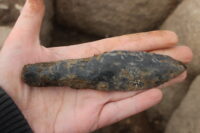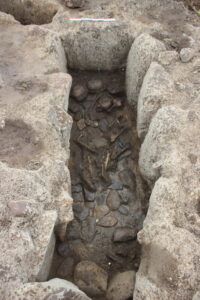An excavation at a gravel pit at Hedehusene, Denmark, has unearthed the remains of four children buried in a single grave from the Neolithic era, and of single child in a Bronze Age grave. The Neolithic burial dates to around 2000 B.C., the Bronze Age, to between 1700 and 1000 B.C.
The two graves were found in a burial mound. That the mound still contained skeletons in good condition is rare enough, but children’s bones are delicate and prehistoric child graves are vanishingly rare finds in Denmark. It isn’t until the late Middle Ages that children’s tombs become more common on the archaeological record.
The children in the Neolithic grave were young, three of them just three or four years old at time of death. The fourth was a little older. The only grave good found buried with them is a small flint dagger. The child in the individual grave was buried with a bronze bracelet.
“Right now it seems like it’s a graveyard dedicated to children. It is interesting in itself with a burial site with so far a time span between the individual graves. It seems as if one has known that it was a children’s graveyard. It’s a mystery why only children are buried here. However, we can not deny that adults have also been here. For example, we have found a bronze blade at the top of the burial mound, and it is not a typical grave gift for children.”
Katrine Ipsen Kjær explains that it is a known phenomenon that burial mounds were reused in the Stone Age and Bronze Age. When you had a deceased person again, you opened in to the burial mound, pushed the old bones aside and laid the body in to the other deceased.
 The bones have been removed for further study. They will be radiocarbon dated to narrow down the date of the burial. If DNA can be extracted, researchers may be able to determine if there were any familial relationships between the deceased. It may also provide information about illnesses they may have suffered.
The bones have been removed for further study. They will be radiocarbon dated to narrow down the date of the burial. If DNA can be extracted, researchers may be able to determine if there were any familial relationships between the deceased. It may also provide information about illnesses they may have suffered.
“Did you bury the four children from the mass grave within a short period of time or over a long period of time? A very short period could indicate a contagious disease,” says [archaeologist] Katrine Ipsen Kjær and concludes:
“It is rare that such old bones contain DNA. But we very much hope that the old bones can give us some answers, because we are dead curious.”

“we are dead curious.” That’s why we’re archaeologists!
Fascinating. Many questions still to be answered. Kind of sad too.
Maud Karlsdottir: you’re so right. When you have children of your own – and grand children(!) it’s so upsetting to see scenes like these and realise how common they were.
I love hearing about history and things found in the soil, but I have to admit, hearing they are keeping the remains of children for further study makes me feel ill. I would prefer they return them to the earth.